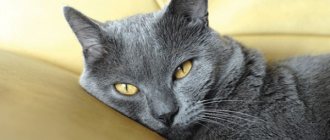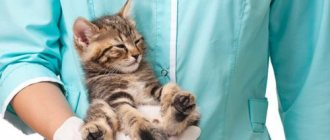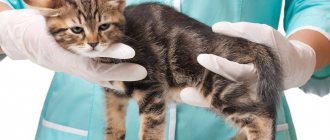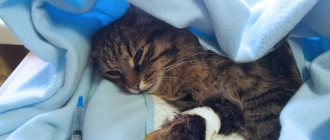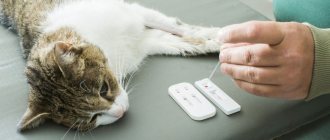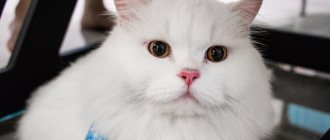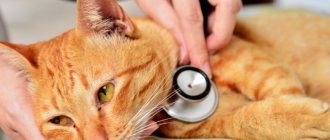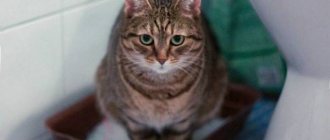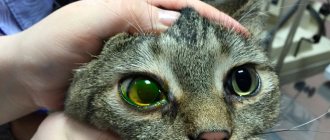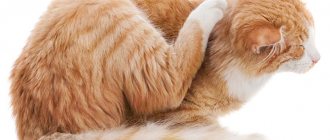Inflammatory liver disease is the second most common cause of liver disease in cats (26%). Other common causes of liver disease are hepatic lipidosis (49%) and lymphosarcoma (7%). The terminology used to describe the histopathological signs of liver disease in cats can be confusing. These terms include: suppurative cholangiohepatitis, chronic cholangiohepatitis, interstitial cholangiohepatitis, pericholangiohepatitis, chronic lymphocytic cholangitis, progressive lymphocytic cholangitis, sclerosing cholangitis, lymphocytic-plasmacytic cholangitis-cholangiohepatitis, lymphocytic cholangitis-cholangiohepatitis, lymphocytic port al hepatitis and biliary cirrhosis.
A number of retrospective studies have classified inflammatory liver diseases (Jones, 1989; Center and Rowland, 1994; Gagnee et al., 1996). The authors examined 175 feline liver biopsies collected at the University of Minnesota Medical Clinic (Gagnee et al., 1996). The results of this study show that inflammatory liver diseases can be divided into two groups: cholangiohepatitis and lymphocytic portal hepatitis. Cholangiohepatitis is divided into acute (purulent) and chronic forms.
Acute (purulent) cholangiohepatitis
Histopathological features of acute cholangiohepatitis include the presence of infiltration of large numbers of neutrophils into the portal areas of the liver and cholangitis (that is, inflammation of the bile ducts). Destruction of the periportal limiting plate leads to disruption of the boundary at the portal sites, periportal necrosis and infiltration of neutrophils into the hepatic lobes. Bile duct hypertrophy and fibrosis are usually mild or absent.
Acute cholangiohepatitis begins as a bacterial infection ascending through the biliary tract. In some sick cats, microorganisms such as Escherichiacoli, Clostridia, Bacteroides, Actinomyces and alpha-hemolytic Streptococcus can be isolated. Diseases of the biliary system, including gallstone formation, and anatomical abnormalities of the gallbladder may predispose cats to cholangiohepatitis. In one retrospective study, 83% of cats with cholangiohepatitis had associated inflammatory infiltrates in the duodenum, jejunum, or both, and 50% had pancreatic lesions. Thus, inflammatory bowel disease, pancreatitis, impaired gallbladder stricture or function, and cholelithiasis may predispose the animal to temporary cholestasis and allow reflux of pancreatic secretions or retrograde bacterial invasion, or both.
Clinical signs of acute cholangiohepatitis are not specific. These include anorexia, weight loss, weakness, somnolence, vomiting and fever (Table 1).
| Table 1. Summary of clinical data in cats with acute and chronic cholangiohepatitis, lymphocytic portal hepatitis and hepatic lipidosis | ||||
| Acute cholangiogapatitis | Chronic cholangiogapatitis | Lymphocytic portal hepatitis | Liver lipidosis | |
| Age (years) | 5,7 | 9,7 | 8,2 | 6,2 |
| Fever (%) | 71 | 11 | 28 | 6 |
| Anorexia(%) | 86 | 78 | 64 | 100 |
| Body weight loss (%) | 86 | 33 | 56 | 88 |
| Diarrhea(%) | 0 | 11 | 28 | 19 |
| Ascites(%) | 14 | 0 | 4 | 6 |
In approximately half of the cases, hepatomegaly can be detected. 90% of cats with acute cholangiohepatitis had neutrophilia or a left shift in the blood count due to an inflammatory response. Serous biochemical abnormalities included normal or slightly elevated alkaline phosphatase (ALP) activity, moderate to markedly elevated alanine aminotransferase (ALT) activity, and moderate to markedly elevated total bilirubin concentrations. Bile acid levels in fasting or post-feeding serum, or both, were also abnormal in affected cats.
Neutrophilic (Bacterial) Cholangitis
Neutrophilic (bacterial) cholangitis is characterized by the infiltration of large numbers of neutrophils into the hilum of the liver and bile ducts, and is usually associated with an ascending bacterial infection, although protozoa are sometimes the cause. The causative agents of feline cholangitis include E. coli, bacteroides, actinomycetes, clostridia and alpha-hemolytic streptococcus. Bile thickening, which can cause partial or complete obstruction of the common bile duct, gallbladder, or intrahepatic bile ducts, often accompanies cholangitis in cats and requires treatment to resolve the cholangitis itself.
Feline neutrophilic cholangitis can be divided into 2 categories:
- spicy
- chronic
Their histological distinction is based on the presence of a large number of plasma cells, lymphocytes, and sometimes macrophages in the chronic stage.
Chronic cholangiohepatitis
Chronic cholangiohepatitis is histopathologically characterized by the presence of a mixed inflammatory infiltrate in the portal areas and bile ducts, consisting of neutrophils, lymphocytes and plasmacytes. Periportal necrosis and moderate to severe bile duct hypertrophy and portal fibrosis are also observed. In the final stage, chronic cholangiohepatitis can develop into biliary cirrhosis.
Chronic cholangiohepatitis can be caused by numerous causes. Some researchers believe that chronic cholangiohepatitis is a chronic form of acute cholangiohepatitis, and others suggest that it is a separate immune-mediated disease resembling primary biliary cirrhosis in humans. Some authors have suggested that the initial bacterial infection causes immune-mediated hepatocellular injury or bile duct destruction or both, which enhance the initial injury. The role of viruses, drugs and chemicals as causes of chronic cholangiohepatitis has not been sufficiently studied. Among the pathogenic viruses were feline infectious peritonitis virus, feline leukemia virus, as well as parasitic agents - toxoplasma and trematode helminths that parasitize the liver (Amphimerus pseudofelineus).
Clinical signs of the disease are similar to those found in acute cholangiohepatitis; however, only 11% of affected cats had an increase in temperature (see Table 1). Common hematologic abnormalities include neutrophilia with a left shift. Biochemical abnormalities in the blood serum include a moderate to marked increase in the concentration of total bilirubin. Bile acid concentrations in fasting, post-feeding, or both samples were also altered in affected cats.
Definition, terminology
Feline cholangitis is an inflammation concentrated in the biliary tree (bile ducts), a common form of liver disease, and apparently the second most common after lipidosis. A new simplified classification scheme proposed by the WSAVA Liver Diseases and Pathologies Standards Study Group suggests 3 different forms of cholangitis in cats:
- Neutrophilic (Bacterial) Cholangitis
- Lymphocytic Cholangitis
- Chronic Cholangitis
The new proposed classification scheme also prefers the term "cholangitis" to "cholangiohepatitis" since inflammatory parenchymal lesions are not always present and, if present, are a complication of primary cholangitis.
Lymphocytic portal hepatitis
Lymphocytic portal hepatitis differs from acute and chronic cholangiohepatitis by the infiltration of lymphocytes and plasmacytes, but not neutrophils, into the portal areas, the absence of cholangitis, and the presence of an intact periportal limiting plate. The number of lymphocytes and plasmacytes in the portal areas ranges from a small number (10-20) to a large number (more than 100). In some cases there are large lymphoid accumulations. Bile duct hypertrophy and portal fibrosis are often observed, but do not progress to pseudolobular formations or biliary cirrhosis. Because the inflammatory infiltrate consists primarily of lymphocytes and plasmacytes, some authors have suggested that lymphocytic portal hepatitis is an immune-mediated disease (Jones, 1989; Center and Rowland, 1994; Gagnee et al., 1996).
Common clinical signs of lymphocytic portal hepatitis are anorexia and weight loss (see Table 1). Vomiting, weakness, drowsiness, fever and diarrhea are less common. In sick cats, the size of the liver increases by about half. In most cats with lymphocytic portal hepatitis, the results of a clinical blood test do not differ from normal ones, with the exception of poikilocytosis, which is observed in 2/3 of affected cats. Characteristic biochemical abnormalities include mild increases in ALP activity, moderate increases in ALT activity, and normal or slightly elevated total bilirubin (Tables 2 and 3).
| Table 2. Summary of clinical laboratory test results in cats with acute (n = 7) and chronic (n = 9) cholangiohepatitis, lymphocytic portal hepatitis (n = 25), hepatic lipidosis (n = 25), and hepatic lymphosarcoma (n = 11) ) | ||||||
| Try | Acceptable range | Acute cholangiohepatitis | Chronic cholangiohepatitis | Lymphocytic portal hepatitis | Liver lipidosis | Lymphosarcoma of the liver |
| Hematocrit (%) | 25,8-41,8 | 33,1 +7,7 | 29,8 ±9,9 | 32,7 + 7,6 | 30,2 + 5,9 | 29,3+12,2 |
| Leukocyte count (x103/µl) | 3,80-19,00 | 14,51 ±7,85 | 13,46 + 7,61 | 11,02 ±7,6 | 10,53 ±3,55 | 20,33 ± 9,7 |
| Segments (x103/µl) | 1,29-16,00 | 11,93 ±7,0 | 11,37 ±6,72 | 8,42 ±7,19 | 8,62 ±3,51 | 12,21 +8,39 |
| Discs (x 103/µl) | 0-0,19 | 0,47 ± 0,71 | 0,07 + 0,12 | 0,08 ±0,18 | 0,05 + 3,14 | 0,06 ±0,16 |
| Serum alkaline phosphatase (U/L) | 12-105 | 48 ±41 | 200+ 196 | 84 ±82 | 426 + 247 | 201±176 |
| Alanine aminotransferase (U/l) | 17-95 | 408 ± 540 | 359 + 348 | 325 + 592 | 349 + 207 | 541+311 |
| Total bilirubin (mg/dl) | 0,1-0,8 | 3,9+ 4,5 | 5,4 ±5,9 | 2,0+ 4,4 | 6,8+ 4,0 | 2,4+ 3,0 |
| Total protein (g/dl) | 4,8-8,7 | 8,6 ±1,3 | 7,0+ 1,3 | 7,5 ± 1,1 | 6,7+ 0,6 | 7,59 ±1,2 |
| Data represent means ± SD | ||||||
| Table 3. Results of a clinical study of laboratory samples that help differentiate acute (n=7) and chronic (n=9) cholangiohepatitis, lymphocytic portal hepatitis (n=25), hepatic lipidosis (n=25) and hepatic lymphosarcoma (n=11) | |||||
| Try | Sharp portal | Chronic cholangiohepatitis | Lymphocytic cholangiohepatitis hepatitis | Liver lipidosis | Lymphosarcoma of the liver |
| White blood cell count >19,000/µl (%) | 28 | And | 12 | 9 | 70 |
| Segments > 16,000/µl (%) | 28 | 22 | 12 | 15 | 45 |
| Discs > 200/µl (%) | 43 | 22 | 20 | 2 | 8 |
| Serum alkaline phosphatase >200 U/l (%) | 0 | 31 | 12 | 78 | 50 |
| Alanine aminotransferase > 200 U/l (%) | 60 | 46 | 20 | 71 | 90 |
| Total bilirubin > 3.0 mg/dl (%) | 50 | 58 | 16 | 71 | 20 |
Concentrations of bile acids taken in the fasting state, after feeding, or both, are often abnormal in affected cats.
Diagnosis
Your veterinarian will perform a physical examination of your cat and will want to run several tests, including blood work, to look at:
- Basic blood tests
- Biochemical profile, complete blood count, and urinalysis to evaluate organs and look for signs of infection or inflammation.
- Bile acid tolerance test. This test evaluates liver function. When a fatty meal is eaten, the gallbladder contracts to release bile into the small intestine to emulsify dietary fats. In cats with a healthy liver, approximately 90% of the bile acids are then reabsorbed into the portal circulation (the blood that goes to the liver) and reabsorbed into liver cells (hepatocytes) to be returned to the gallbladder. In cats with liver disease, hepatocytes are unable to perform this role effectively and bile leaks into the blood supply. The bile acid test measures the level of bile in the blood before eating a fatty meal and then two hours later. Elevated levels of bile acids indicate liver failure.
- A general clinical blood test allows you to assess the type of inflammatory reaction of the body and anemic syndrome.
Treatment of acute cholangiohepatitis
Treatment of cats with acute cholangiohepatitis includes antimicrobial therapy and restoration and maintenance of normal fluid-salt balance. In the presence of extrahepatic obstruction of the bile ducts, surgical decompression and biliary or intestinal diversion (cholecystojejunostomy) are recommended.
Antimicrobial therapy is the main type of treatment for acute cholangiohepatitis. When possible, bacterial culture and bile sensitivity testing, liver biopsy or aspiration, gallstones, or gallbladder should be used to select appropriate antimicrobials. The antibiotics used must be released in the bile in an active form, be effective against aerobic and anaerobic intestinal coliform bacteria, and must not be hepatotoxic. Penicillin, trimethoprim-sulfa drugs, aminoglycosides and first-generation cephalosporins may not be effective because they are not excreted in the bile in an active form. Tetracycline, erythromycin, ampicillin, chloramphenicol and metronidazole are excreted in the bile in an active form and, therefore, are more effective. However, tetracycline is hepatotoxic, erythromycin is not effective against gram-negative bacteria, and chloramphenicol causes anorexia. Anorexia caused by chloramphenicol can be avoided by giving cats a relatively small dose of the drug (50 mg orally every 12 hours). Ampicillin is a broad-spectrum antibiotic and is well tolerated by cats. Metronidazole is effective against anaerobes and coliform bacteria.
Combination antibiotic therapy is recommended using ampicillin (20-40 mg/kg po every 8 hours), chloramphenicol (50 mg po every 12 hours) and metronidazole (10-25 mg/kg, maximum dose 50 mg, p/o every 24 hours) (Zawie and Garvey, 1984). Antibiotic treatment is recommended for 3 months.
Urodeoxycholic acid is a bile dihydroxy acid used to dissolve gallstones and treat chronic cholestatic liver disease in humans. Treatment with urodeoxycholic acid results in marked clinical and biochemical improvement, possibly due to a reduction in cell membrane disruption caused by bile acid retention. Udeoxycholic acid has also been shown to reduce the expression of class 2 histocompatibility antigens on hepatocytes and bile duct epithelium, which may be important in reducing immune damage to hepatocytes. Urodeoxycholic acid was given to cats at 10-15 mg/kg orally every 24 hours.
If specific complications occur, some cats may require additional treatment. In cats with acute cholangiohepatitis, the disease often occurs in an acute form and there is a violation of the water-salt balance, which needs to be brought back to normal. If hemorrhagic diathesis occurs, vitamin K injections can be given (5 mg per cat IM every 1-2 days). Hepatic encephalopathy can be treated by giving animals oral lactulose (2.5-5 ml per cat po every 8 hours) with the addition of enteric antibiotics (neomycin 20 mg/kg po every 8-12 hours).
To monitor the progress of treatment, it is necessary to frequently repeat clinical analysis and blood biochemistry. A persistent increase in ALT activity and serum total bilirubin concentration or an increase in ALP activity, or both, indicates treatment failure.
Forecast
The prognosis for cats with neutrophilic cholangitis is worse than for cats with lymphocytic cholangitis. Cats with lymphocytic cholangitis may survive several months to several years.
^Top
Cholangiohepatitis is a common form of liver disease that affects cats of any age or breed. Cats with this disease develop inflammation of the liver and bile ducts. Cholangiohepatitis can be acute (purulent) or chronic (non-purulent). Young male cats appear to be more likely to develop cholangiohepatitis than male cats.
The liver is responsible for many important functions, including the metabolism of carbohydrates and fats, the synthesis of proteins and vitamins, the storage of vitamins and iron, the production of substances necessary for blood clotting, and the removal or breakdown of toxins. Because the liver is involved in many important biological functions, a cat with liver disease may experience a wide range of symptoms. Symptoms may include lethargy, decreased appetite, weight loss, weakness, jaundice (yellowing of the skin, eyes and gums), vomiting, diarrhea and behavioral changes. Some cats are diagnosed early in the disease, before clinical signs appear.
Diagnostics
Diagnosis is made through a physical examination and a thorough history of the animal, including diet and medications. In addition, the veterinarian takes blood for analysis and performs an abdominal ultrasound examination. A definitive diagnosis of cholangiohepatitis requires a liver biopsy. The biopsy can be performed surgically, through laparoscopy, or through the skin using a special needle under ultrasound guidance. Unfortunately, ultrasound-guided biopsies are not as informative as surgical or laparoscopic biopsies. Information obtained from a biopsy is necessary to determine the type and severity of liver disease, as well as to assess the disease's prognosis and determine appropriate treatment options.
Some cats with cholangiohepatitis simultaneously suffer from chronic pancreatitis (inflammation of the pancreas) and/or inflammatory bowel disease (inflammation of the stomach and small intestine). The condition when a cat is diagnosed with all three of these diseases at the same time is called “triaditis”. There are special blood tests that can help your veterinarian determine whether your cat may be suffering from this combination of conditions.
Treatment
Treatment of cholangioepatitis can be quite complex and is determined by the severity of the disease. In severe cases, hospitalization, intravenous fluid therapy, and supportive care may be required. Acute cholangiohepatitis is often treated with long courses of antibiotics, drugs that help liver regeneration, antioxidants and other supplements. Medicines used to treat chronic cholangioepatitis include immunosuppressants or anti-inflammatory drugs in addition to the medications listed above. Treatment plans for cats with other underlying conditions, such as chronic pancreatitis or inflammatory bowel disease, involve a combination of medications and diet.
Forecast
The liver has an amazing ability to heal itself and can regenerate if the underlying disease is treated. Cats with liver infections can make a full recovery with appropriate long-term treatments. The prognosis for cats with chronic cholangiohepatitis is more guarded. Some cats recover permanently, while others suffer from intermittent bouts of illness. Most cats require close veterinary monitoring for the rest of their lives. Such monitoring includes periodic medical examinations, blood tests and sometimes repeat examinations such as abdominal ultrasound.
Cholangiohepatitis is an inflammation of the liver and bile ducts.
The wide prevalence of cholangiohepatitis in cats is associated with the peculiarities of their anatomy: the pancreatic duct and the gallbladder ducts connect before emptying into the duodenum. Therefore, inflammation of the small intestine or pancreatitis (inflammation of the pancreas) also leads to inflammation of the bile ducts (cholangitis).
Cholangiohepatitis can manifest itself in acute and chronic forms.
The acute form occurs more often in young cats. It begins with a sudden refusal to feed and lethargy. Vomiting appears, body temperature often rises, and the abdominal area is painful. With acute hepatitis, dehydration quickly occurs. After this, the so-called “jaundice” or icterus (yellowish tint of the skin and mucous membranes), which is noticeable on the sclera of the eyes and gums. During this period, the activity of liver enzymes, bilirubin and the number of leukocytes in the animal’s blood increases.
The chronic form of cholangiohepatitis is more common than the acute form, and older cats are more prone to it. Symptoms with this course appear and disappear in periods, with periods of exacerbation often associated with stress.
Depending on the type of cells that are found during microscopy of liver samples, chronic cholangiohepatitis may have different names. If lymphocytes predominate, it is called lymphocytic cholangiohepatitis; if neutrophils - then neutrophilic; if other defense cells (macrophages, plasmacytes) – then granulomatous.
All forms of cholangiohepatitis can eventually lead to liver atrophy (cirrhosis).
The causes of acute cholangiohepatitis are often bacterial infections that pass to the liver from the small intestine (duodenum) and pancreas. In addition, acute cholangiohepatitis can be caused by coronavirus infection, intoxication, or feeding with low-quality or unbalanced feed.
Among the causes of chronic cholangiohepatitis, genetic predisposition comes first; it can also be due to an autoimmune disease, helminthiasis, cystoisosporosis, or malnutrition.
Complications of hepatitis:
- Hepatic lipidosis. Cats do not tolerate periods of not eating well (anorexia). At this time, their liver often begins to store fat, which leads to lipidosis; the functional liver tissue is irreversibly replaced by fatty tissue. Cats with a lack of appetite due to cholangiohepatitis are at risk.
- Hepatic encephalopathy. Due to increased levels of ammonia and other unwanted components in the blood, brain damage occurs.
- Portal hypertension and the formation of free fluid in the abdominal cavity (ascites).
- Sometimes chronic cholangiohepatitis progresses to cancer. In humans, there has been a proven connection between chronic stimulation of lymphocytes and the occurrence of malignant lymphoma. Therefore, it is likely that chronic lymphocytic cholangiohepatitis in cats can provoke lymphoma and malignant abnormalities of lymphocytes.
Diagnosis of hepatitis
- General clinical examination of the animal.
- General clinical and biochemical blood test. The presence of hepatitis or chronic inflammation of the intestines and pancreas is indicated by a high level of GGT, an increase in ALT and alkaline phosphatase with normal levels of thyroid hormones. The level of bilirubin and globulins also increases, cobalamin and folic acid decrease.
- Serological studies. Used for suspected viral infections (feline leukemia, feline immunodeficiency, feline viral peritonitis), as well as toxoplasmosis.
- X-ray examination.
- Ultrasound of the abdominal cavity (is important in diagnosing cholangiohepatitis or obstruction (blockage) of the bile duct).
- Liver biopsy. A needle is inserted through the abdominal wall into the animal's liver and material is collected for further research. The best way to diagnose hepatitis is by examining small pieces of the animal's liver. They are obtained by exploratory laparotomy (surgically) or by biopsy. Both procedures pose a certain risk and must be carried out with extreme caution, because in severe cases of the disease, the affected organs may bleed during puncture, and anesthesia poses a risk to the sick animal.
- Bacterial culture of liver and bile. If liver and bile samples can be obtained for pathological examination, it may be possible to test them for the presence of bacteria.
Treatment
- stabilization of the body's condition in critical cases (intravenous therapy with electrolyte solutions). If necessary, artificial or parenteral nutrition and antiemetics are prescribed;
- antibiotics;
- choleretics and hydrocholeretics (substances that help the passage of bile from the liver to the intestines). They are prescribed to prevent bile stagnation, because this is one of the main phenomena of cholangiohepatitis;
- anti-inflammatory drugs;
- immunosuppressants (prescribed for lymphocytic portal hepatitis);
- vitamins K, E, B12. With cholangiohepatitis, the ability to absorb these vitamins through the intestines is reduced. In some cases, the use of taurine, folic acid and L-carnitine is also indicated.
Diet
The cat should be switched to a diet containing a reduced amount of sodium, carbohydrates and an increased amount of protein. It is not advisable to feed your animal food containing sucrose or fructose.
To avoid hepatic encephalopathy, if the level of ammonia in the blood of a particular animal is elevated, the amount of protein in its diet should be limited, because Protein is the main source of ammonia in the body. It is very important to feed your cat small meals multiple times throughout the day.
Prognosis for hepatitis in cats
The liver is an organ that recovers well in the event of a sudden crisis, provided that some of its cells (hepatocytes) remain intact. Therefore, a cat with an acute form of hepatitis is not difficult to cure. However, with chronic hepatitis the situation is different. Diet and proper treatment help improve the animal’s condition, although the chronic form of the disease is not completely cured. The animal can live a normal life if the conditions of detention and therapeutic feeding are observed, although the disease can worsen with any stress. The prognosis is less favorable for cats with advanced stages of hepatitis, when many systems are susceptible to inflammation and the disease has approached the early stages of leukemia (lymphoma).
The article was prepared by veterinarian A.A. Merkulov.
Inflammatory liver disease is the second most common cause of liver disease in cats (26%). Other common causes of liver disease are hepatic lipidosis (49%) and lymphosarcoma (7%). The terminology used to describe the histopathological signs of liver disease in cats can be confusing. These terms include: suppurative cholangiohepatitis, chronic cholangiohepatitis, interstitial cholangiohepatitis, pericholangiohepatitis, chronic lymphocytic cholangitis, progressive lymphocytic cholangitis, sclerosing cholangitis, lymphocytic-plasmacytic cholangitis-cholangiohepatitis, lymphocytic cholangitis-cholangiohepatitis, lymphocytic port al hepatitis and biliary cirrhosis.
A number of retrospective studies have classified inflammatory liver diseases (Jones, 1989; Center and Rowland, 1994; Gagnee et al., 1996). The authors examined 175 feline liver biopsies collected at the University of Minnesota Medical Clinic (Gagnee et al., 1996). The results of this study show that inflammatory liver diseases can be divided into two groups: cholangiohepatitis and lymphocytic portal hepatitis. Cholangiohepatitis is divided into acute (purulent) and chronic forms.
Treatment of lymphocytic portal hepatitis
Treatment of lymphocytic portal hepatitis is based on the hypothesis that liver damage is immune-mediated. Treatment of lymphocytic portal hepatitis was carried out with immunosuppressive doses of corticosteroids, as previously described for chronic cholangiohepatitis. After treatment with prednisone, there are occasional cases of long-term remission (Jones, 1989)', but other data indicate a weak effect of such treatment in this disease (Center and Rowland, 1994). Azathioprine (0.3 mg/kg po every 24 hours) has been tried, but adverse reactions such as lack of appetite and leukopenia limit its use. A small number of sick cats were given small doses of the drug once a week.
The response to treatment for lymphocytic portal hepatitis is difficult to assess due to the slow progression of the disease. A persistent increase in ALT activity or an increase in serum total bilirubin concentration during corticosteroid treatment, or both, indicates ineffective treatment of the disease. In this case, it probably makes sense to switch to non-steroidal immunosuppressive drugs.
Clinical picture
Symptoms of cholangitis in cats will depend on the type of pathology. The purulent variety is characterized by an acute onset with a rapid increase in symptoms. The cat has vomiting, loss of appetite, abnormal bowel movements, jaundice, and general lethargy.
Jaundice in cats is manifested by changes in the color of the skin and mucous membranes. You can notice this sign in areas of the body that are minimally covered with hair (ears, belly, groin). Icterus is also clearly visible on the sclera, mucous membrane of the eyes and mouth: a pronounced yellow tint to the tissues will be noted.
Important! Neutrophilic (purulent) cholangitis progresses quickly and is especially dangerous for the animal’s body. In the absence of timely help, the disease can be fatal.
The non-purulent variety of the disease is characterized by a sluggish course, slow progression and chronicity. Most often, this condition is observed in older cats and it is not always possible to immediately suspect the development of pathology. The animal's appetite worsens, frequent vomiting appears, rapid weight loss is noted, and jaundice gradually develops.
Important! The chronic course of the pathology is dangerous due to the occurrence of complications in the form of abdominal dropsy.
Prognosis for lymphocytic portal hepatitis
Of the 25 cases of lymphocytic portal hepatitis included in the authors' retrospective study, 13 cases of animals were treated with antibiotics, 4 were given anti-inflammatory doses of corticosteroids, and 3 were treated with immunosuppressive doses of corticosteroids. Half of the cats were not treated with antimicrobials or corticosteroids. Of the 23 cats that were brought in for retesting, 30% lived less than 1 year, 44% lived 1-5 years, and 26% lived more than 5 years. The average lifespan for cats surviving more than a year was 51.8 months, with 22% of cats still alive at the time of examination.
Diagnostics
When the first signs of disease development appear (vomiting, loss of appetite, lethargy, jaundice), you should immediately consult a veterinarian.
Diagnostic methods include examination, laboratory and instrumental examination methods. Based on the clinical picture data, the veterinarian carries out differential diagnosis with the following types of pathological conditions:
- poisoning with toxic and medicinal substances with liver damage;
- infectious peritonitis;
- liver lipidosis;
- hepatic trematodosis;
- liver neoplasms.
To make a diagnosis, your cat may undergo the following tests:
- general and biochemical blood test;
- Analysis of urine;
- X-ray examination of the abdominal cavity;
- Ultrasound;
- percutaneous liver biopsy;
- laparoscopy.
A blood test will show increased levels of bilirubin, anemia, leukocytosis, and increased levels of bile acids in the blood serum. Ultrasound and x-rays show a characteristic enlargement of the liver, obstruction of the bile ducts and stagnation of bile.
With the help of laparoscopy, the veterinarian will be able to thoroughly examine the liver, bile ducts, gallbladder, and also obtain biological materials for biopsy. However, despite the high information content of this method, it is rarely performed.
Liver biopsy, which is performed percutaneously, is of great importance for making the correct diagnosis. The procedure is carried out after the animal’s condition has stabilized.
Therapy for cholangitis in cats involves the use of medications. If the bile ducts are obstructed, surgery is performed. Emergency surgery is performed if signs of peritonitis appear.
Among medications, antibiotics are of primary importance. They are prescribed for the treatment of any type of cholangitis. In therapy, amoxicillin (for the activity of anaerobic bacteria) and aminoglycosides (for the activity of anaerobic infection) are most often used. Contraindication is the use of tetracycline, which has hepatotoxic properties.
In the treatment of lymphocytic and lymphoplasmacytic type, immunomodulators (prednisolone) are used.
Vitamin K is prescribed in case of increased blood clotting time.
To maintain liver function, it is possible to use hepatoprotectors. They prevent the destruction of cell structures and stimulate their regeneration.
During the treatment process, it is necessary to improve the cat's nutrition. It is recommended to use easily digestible food (or natural food) with a low protein content.
Treatment of cholangitis takes a long time. Its duration can range from several weeks to several months. At this time, additional tests will be required to monitor the condition.
Every 2 weeks a repeat biochemical blood test with liver enzyme testing is required. If the disease does not resolve within 4-6 weeks, an additional liver biopsy is performed.
This pathology requires stable drug therapy. In case of inadequate or delayed treatment, there is a risk of complications (ascites, hepatic encephalopathy).
The purulent type of pathology, despite its acute course, has a more favorable prognosis. Other types of disease quite often lead to cirrhosis of the liver.
Most common liver diseases
There are many parenchymal organ pathologies found in animals. Some diseases are diagnosed most often, while others occur extremely rarely. The most common liver diseases in cats are:
- hepatitis;
- hepatosis (liver degeneration);
- neutrophilic and lymphocytic cholangitis;
- poisoning;
- carcinoma (malignant tumor);
- hepatic lipidosis;
- cirrhosis.
Cats are no less susceptible to cancer than other animals. Tumors affecting the liver can develop either directly in the organ itself or penetrate into it from other systems of the body.
A tumor such as carcinoma usually affects the bile duct of the liver. Basically, cancerous tumors of the organ occur in older animals and are the result of metastasis of cancer pathologies in other parts of the body.
In very rare cases, the tumor develops from hepatocytes.
Liver cancer in cats is virtually untreatable, but chemotherapy can significantly slow the growth of tumors.
Most often, cats suffer from dystrophy (hepatosis of the liver in cats), various toxic damage to the organ caused by exposure to poisons and harmful substances, and the penetration of infectious agents that provoke hepatitis.
Feline liver diseases always cause serious harm to the animal’s body and are not subject to effective treatment in all cases.
As a rule, the life of a cat can be extended if its owners promptly paid attention to the suspicious symptoms that appeared in their furry pet.
Some diseases, in the absence of competent assistance from a veterinarian, quickly lead to liver or kidney failure.
Neutrophilic cholangitis
The disease occurs when a bacterial infection enters the liver and leads to inflammation of the organ. The disease often occurs along with pancreatitis and intestinal diseases.
To diagnose neutrophilic cholangitis, a biopsy is required (to grow a culture of the pathogen). Treatment of the disease involves the use of antimicrobial drugs. If treatment is started on time, the further prognosis of the disease is favorable.
Lymphocytic cholangitis
A disease of non-infectious nature. The exact causes of the pathology are not fully understood, but most experts claim that lymphocytic cholangitis is the result of a disorder of the immune system.
The disease leads to an increase in the size of the liver, as well as accumulation of fluid in the peritoneum. The disease is diagnosed by biopsy. In most cases, the pathology is treatable, although there is a considerable percentage of relapses.
Hepatic lipidosis
Hepatic lipidosis in cats occurs as a result of the conversion of liver cells to fat cells. It is characterized by severe damage and swelling of the parenchymal organ, as well as a significant decrease in its function.
Most often, pathology is observed in overweight animals. Lipidosis is diagnosed by biopsy.
Poisoning
Cats, especially more often than other animals, are susceptible to various poisonings, since the parenchymal organ of furry creatures is not able to fight many poisons and toxins.
Poisoning leads to the development of diseases such as hepatitis, lipidosis, cirrhosis, etc.
Hepatitis
Hepatitis is a serious disease of a parenchymal organ and leads to cell destruction. As a result of the disease, the basic functions of the organ, as well as all metabolic processes occurring in the body, are disrupted.
Hepatitis can be toxic (the entry of poisons into the animal’s body) and infectious (the introduction of viruses or bacteria into organs and tissues).
Hepatosis
It is characterized by a degenerative process occurring in the liver, as a result of which hepatocytes become incapable of normal functioning.
The signs of hepatosis are very similar to the symptoms of hepatitis, however, the first pathology can occur for a long time without any inflammatory manifestations. Hepatosis is diagnosed using a biochemical blood test and biopsy.
Cirrhosis
Liver cirrhosis in cats is a severe pathology, which results in the proliferation of connective tissue in the parenchymal organ.
The structure of the liver affected by cirrhosis changes and its functions are impaired. The organ greatly increases in size, and fluid forms in the abdominal cavity. The disease cannot be treated.
Diagnostic procedures
In the course of differential diagnosis, an ultrasound is prescribed for the fluffy.
Lymphocytic cholangitis has symptoms similar to other pathologies of the hepatobiliary system, so it is important to identify the type of disease. The veterinarian conducts an external examination, listens to the owner’s complaints, finds out what the animal ate and prescribes diagnostic methods, such as:
- stool analysis for worm eggs;
- general clinical and biochemical blood test (liver tests);
- Ultrasound of the bile ducts;
- biopsy;
- histological examination.
Prevention of liver disease in cats
Preventive measures to prevent the development of diseases consist of simple rules:
- prevent poisoning of the animal;
- feed your cat quality food;
- prevent the formation of infectious and invasive diseases;
- Regularly vaccinate and combat helminths.
Liver diseases in cats are easier to prevent, since further treatment of the pathology is always complex and lengthy. It is important to provide the animal with quality care and concern, and always pay attention to the slightest changes in the pet’s health.
Inflammatory liver disease is the second most common cause of liver disease in cats (26%). Other common causes of liver disease are hepatic lipidosis (49%) and lymphosarcoma (7%). The terminology used to describe the histopathological signs of liver disease in cats can be confusing. These terms include: suppurative cholangiohepatitis, chronic cholangiohepatitis, interstitial cholangiohepatitis, pericholangiohepatitis, chronic lymphocytic cholangitis, progressive lymphocytic cholangitis, sclerosing cholangitis, lymphocytic-plasmacytic cholangitis-cholangiohepatitis, lymphocytic cholangitis-cholangiohepatitis, lymphocytic port al hepatitis and biliary cirrhosis.
A number of retrospective studies have classified inflammatory liver diseases (Jones, 1989; Center and Rowland, 1994; Gagnee et al., 1996). The authors examined 175 feline liver biopsies collected at the University of Minnesota Medical Clinic (Gagnee et al., 1996). The results of this study show that inflammatory liver diseases can be divided into two groups: cholangiohepatitis and lymphocytic portal hepatitis. Cholangiohepatitis is divided into acute (purulent) and chronic forms.
Causes and clinical manifestations
The acute neutrophilic form is caused by a bacterial infection. Microorganisms enter the liver from the intestines, moving up the bile ducts. It is believed that the chronic neutrophilic form is a consequence of the acute variety. The cause of the lymphocytic form has not yet been precisely identified, but experts suggest that autoimmune diseases are to blame, when the body begins to attack itself.
There is a group of factors called the “trinity” or “triad”. In this case, cholangitis is accompanied by pancreatitis and inflammatory bowel diseases. It is difficult to say which disease occurs first and “pushes” the development of other pathologies.
What are the symptoms of cholangitis in cats? Signs vary depending on the type of disease. The acute neutrophilic type causes a rapid deterioration in the animal’s condition and can be fatal. The cat vomits, has no appetite, and develops profuse diarrhea. Intermittent fever is possible. The acute form of the disease is more common in relatively young cats; cats get sick much less often.
On the contrary, chronic neutrophilic cholangitis is more often detected in cats, and older ones at that. The animal suffers from persistent vomiting, the skin and all visible mucous membranes turn yellow. The chronic variety is dangerous due to the development of ascites (edema of the abdominal cavity). The parasitic type manifests itself in approximately the same way, but it is more characterized by severe pain in the right hypochondrium. The diagnosis is made based on the following studies:
- Complete medical examination of the animal, taking blood and urine tests. Blood biochemistry often shows an increase in liver enzymes and bilirubin.
- An ultrasound examination will help determine what exactly is affected - the liver, its ducts, or the entire tissue of the organ. A biopsy is very desirable, since with its help it is possible to accurately identify the type of disease and prescribe treatment.
- If parasitic cholangitis is suspected, a stool sample is taken.
- Therapeutic techniques
Treatment for cholangitis in cats depends on its type. Because acute neutrophilic cholangitis is associated with a bacterial infection, antibiotics are a key component of therapy. Unfortunately, the course of treatment often lasts several weeks. In chronic neutrophilic and lymphocytic cholangitis, the goal is to reduce inflammation. are used , and sometimes more powerful immunosuppressants are used. For cholangitis associated with liver flukes, praziquantel and drugs based on it are used.
Regardless of the type of disease, replacement therapy is necessary to allow the organ to fully recover.
Various hepatoprojectors are prescribed for this purpose. In addition, treatment involves:
- Vitamin K and E injections.
- Painkillers.
- Liquid broths without fat as food.
- Ursodeoxycholic acid. Used to stimulate bile secretion and reduce the intensity of inflammation.
- If the flow of bile is blocked by something (stones, adhesions), surgical intervention is necessary.
Symptoms: how to recognize the disease?
During the inflammatory process, the liver structures are attacked by cells, so the disease is divided into granulomatous, neutrophilic and lymphocytic. Veterinarians distinguish 2 forms of cholangiohepatitis in cats:
- Acute, in which the disease begins suddenly and is acute.
- Chronic, characterized by a period of remission and exacerbation.
Depending on the type of disease, the symptoms differ as shown in the table:
| Pharmgroup | Veterinary medicine |
| Hepatoprotectors | "Hepatovet" |
| "Divopride" | |
| "Vet Expert" | |
| "Gepasafe" | |
| Antibiotics | "Marfloxin" |
| "Amoxicillin" | |
| "Sinulox" | |
| Antiemetics | "Cerucal" |
| Choleretic | "Allohol" |
| Vitamins | Injections of vitamin E, K, B12 |
Return to contents
Medical nutrition
If the liver and bile ducts are inflamed, treats from the table, fried, smoked, and salted should be excluded from the cat’s diet. It is recommended to switch the animal to dietary food:
- Royal Canin Hepatic;
- Hills Diet Felin;
- "Farmina Hepatic";
- "Purina Pro Plan Veterinary Diets Hepatic."
At the same time, you can give the animal the following products:
- lean meats and fish that have undergone heat treatment;
- lean broth;
- carrots or potatoes, steamed or boiled;
- rice or oatmeal porridge with water;
- low-fat dairy products.
Return to contents
Treatment at home
Therapy with herbal remedies can only be carried out after consultation with a veterinarian, but it should not replace traditional treatment.
To restore the functions of the liver and bile ducts, chamomile, yarrow, dandelion root, nettle, and plantain are used. You can use ready-made feed mixture “Fitomina”. A decoction of herbs that should be gradually infused into the cat using a syringe without a needle is effective. Preparation:
- Take 5 g of any plant and pour 200 ml of hot water.
- Let it brew for 20-30 minutes, cool, filter.
- Dilute the resulting broth with cool water.
- Give the cat 5 ml 3 times. in a day.
Return to contents
What it is?
This is the name for inflammation of the bile ducts . If in this case the entire liver is inflamed, the disease can be characterized as “cholangiohepatitis”. The disease is quite serious, as it often leads to obstruction of the bile ducts . Bile is extremely important for the digestion of fats, so a sick cat will quickly develop digestive problems. If nothing is done, cholemia will occur, which can be fatal.
There are three main types of cholangitis in cats:
- Neutrophilic variety . When examining a liver sample, it is discovered that the organ tissue is literally saturated with neutrophils. It can occur in both acute and chronic forms.
- Lymphocytic type . Accordingly, when examining tissue samples, a large number of lymphocytes are found.
- In the third case, the disease develops against the background of opisthorchiasis , a parasitic disease.
